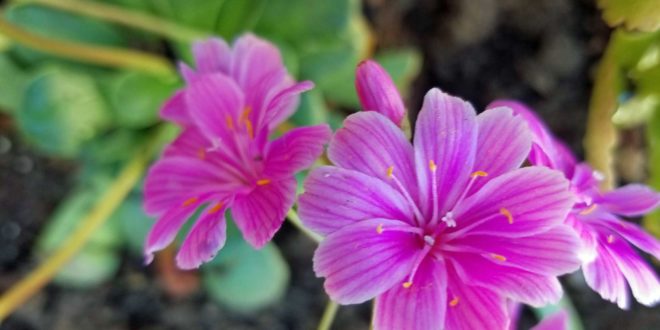New to our Sunnyvale garden in 2019 is Lewisia cotyledon, commonly known as Siskiyou lewisia. Lewisia blooms from spring to mid-summer, producing large individual six-petal flowers in orange, pink, red, salmon, white or yellow that are held high above the foliage in a spray, lasting for several weeks. Lewisia is eye-catching in bloom, although, when grown from seed, it is slow to reach the size needded for transplanting into larger containers or its final display area.
Lewisia Siskiyou is native to the Siskiyou mountains of Northern Californa and Southern Oregon. It requires excellent drainage in a rich gritty soil, originating as it does in the high mountains in North America, but it also needs frequent water and a cool root run.
Lewisia’s ideal conditions are in a crevice garden or planted on a slope, where they can obtain the perfect drainage they require. If you have a knack with challenging plants that require a certain benign neglect, these may just be the plants for you to try and grow with seed propagation.
I purchased my Lewisia plants from Yerba Buena Native Nursery in Half Moon Bay, CA.
Lewisia is an evergreen perennial plant that is hardy in U.S. Department of Agriculture Hardiness zones 3 to 8. In two to five years it grows to a mature height of 9 to 12 inches. The soil for this plant must drain very quickly as it does not tolerate muddy, water-logged soil. It is well-suited to growing in landscaped areas with organically rich soil and rock gardens but can also be grown in containers.
If planting in a Rock garden
Select a planting site for the Siskiyou lewisia that receives a minimum of four hours of direct sunlight each day. Spread a 3-inch deep layer of well-aged cow manure or compost over the planting site soil. Mix it into the soil with a dirt shovel or rototiller to a depth of 10 to 12 inches. Add perlite to improve the soil’s drainage capabilities, if necessary. Use a hand shovel to mix the amendments into the soil thoroughly between the rocks in a rock garden.
Dig a planting hole for each Siskiyou lewisia with a hand shovel. Make the holes deep enough to set the plants at the same level in the soil as they were previously growing. Water them generously to settle the soil.
Spread a 2- to 3-inch depth of mulch beneath the plants. Continue to water them once or twice each week during the spring, summer and fall in the absence of rainfall. Keep the soil uniformly moist. Do not water them throughout the winter.
If planting in Containers
Select a container for the Siskiyou lewisia that has drain holes in the bottom. The plant has a long tap-root (like a carrot). Use a 6- to 8-inch diameter container for a single plant. Use a 12-inch diameter or larger container for multiple plants.
Pour a 2- to 3-inch depth of potting mix into the bottom of the container. Moisten it with room-temperature water.
Place the roots of the Siskiyou lewisia plant into the container on top of the moistened potting mix. Make sure it will be at the same depth in the soil within the container as it was growing previously. Add more moistened potting mix into the bottom of the container, if necessary, to bring it up to the proper height. Fill in around the roots with more potting mix until the top of the soil is 1 inch below the top lip of the container.
Water the newly-planted Siskiyou lewisia until the water pours from the bottom of the container. Set the container in a location where the plant will be exposed to four to eight hours of direct sunlight each day.
Check the potting mix with a finger every day or every other day to determine if it is moist. Water the Siskiyou lewisia when the top of the soil just begins to dry. Do not allow the soil to dry out between waterings.
After blooming, Lewisia should be allowed to dry a little to rest. Some species such as L. nevadensis and L.oppositifolia are summer dormant, losing their leaves and disappearing. I suspect that a lot of these plants are summarily pulled up when the novice grower thinks they are dead. If left, they will re-emerge to bloom again the following season.
Unfortunately, once the flowering season is over, Lewisia tends to be forgotten, as just a clump of green leaves in a rosette. An exception to this trait is Lewisii ‘George Henry’, which will bloom from May until the autumn.
The foliage of most Lewisia is attractive enough; usually grey or blue green, spoon shaped leaves emerging from a central point stay fresh all season. Typically, there is a down curving point on the outer edge of the leaves.
Many hybrids have arisen from the species once common in rock gardens of collectors. Some species which have been used to hybridize are also still around in their original form such as L. columbiana, L. cotyledon, L. finchae, L. heckneri, L. howellii, l. mariana and L. purdyi. Many others have inter married and formed some of the most beautiful hybrids such as Lewisia ‘Pinkie’, short little dwarf plants with lots of narrow petalled pink flowers.
Other species such as L. tweedyi have never been hybridized. Many different forms are available with flowers in shades of apricot, yellow and pink and some types are seen with deep rose red and even white albino flowers.
Companion plants:
- Phlox subulate (creeping phlox)
- Sempervivum (Hens and chicks)
- Tiger lilies
- amartagon lilies
- Salvias








